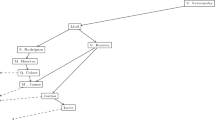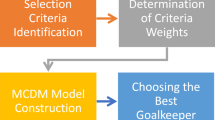Abstract
In this paper we apply a recently introduced multiple criteria decision aiding method, namely the SMAA–Choquet method, to compare the performances of different sailboats in regattas. In sailing races where sailboats with different design can participate, the performances of the boats can be evaluated by using different scoring options. In each scoring option, a corrected time is computed taking into account the physical characteristics and the performances of the sailboats. While, in real competitions, the final ranking of the sailboats is obtained by using only one of the considered scoring options, in this paper we propose to aggregate the time values computed by these scoring options in a unique one. Since the time values computed by the scoring options are given on different scales and a certain degree of interaction between them could be observed, we apply the SMAA–Choquet method that is able to deal with both aspects simultaneously.

Similar content being viewed by others
Notes
Supposing that all criteria have an increasing direction of preference, \(a_h\) dominates \(a_k\) if \(g_i(a_h)\ge g_i(a_k)\) for all \(i=1,\ldots ,n\), and there exists at least one \(i\in \{1,\ldots ,n\}\) such that \(g_i(a_h)>g_i(a_k)\).
Official website of the ORC: http://www.orc.org.
Official website of the Syracuse–Malta regatta: http://www.rmyc.org/races/archive/?id=115&page=4.
Official website of the Syracuse–Malta regatta: http://www.rmyc.org/races/archive/?id=115&page=4.
The Performance Line is a linearization of the Performance Curve which is a function that, given the wind speed, gives back the speed of the sailboat.
References
Angilella S, Greco S, Lamantia F, Matarazzo B (2004) Assessing non-additive utility for multicriteria decision aid. Eur J Oper Res 158(3):734–744
Angilella S, Greco S, Matarazzo B (2010) Non-additive robust ordinal regression: a multiple criteria decision model based on the Choquet integral. Eur J Oper Res 201(1):277–288
Angilella S, Corrente S, Greco S (2015) Stochastic multiobjective acceptability analysis for the Choquet integral preference model and the scale construction problem. Eur J Oper Res 240(1):172–182
Bana e Costa C, Vansnick J-C (1994) MACBETH—an interactive path towards the construction of cardinal value functions. Int Trans Oper Res 1(4):489–500
Barron FH, Barrett BE (1996) Decision quality using ranked attribute weights. Manag Sci 42(11):1515–1523
Brans JP, Vincke Ph (1985) A preference ranking organisation method: the PROMETHEE method for MCDM. Manag Sci 31(6):647–656
Chateauneuf A, Jaffray JY (1989) Some characterizations of lower probabilities and other monotone capacities through the use of Möbius inversion. Math Soc Sci 17:263–283
Choquet G (1953) Theory of capacities. Ann Inst Fourier 5:131–295
Corrente S, Greco S, Ishizaka A (2016) Analytical hierarchy process and Choquet integral within non-additive robust ordinal regression. Omega. doi:10.1016/j.omega.2015.07.003
Dadelo S, Turskis Z, Zavadskas EK, Dadeliene R (2014) Multi-criteria assessment and ranking system of sport team formation based on objective-measured values of criteria set. Expert Syst Appl 41(14):6106–6113
Dey PK, Ghosh DN, Mondal AC (2011) A MCDM approach for evaluating bowlers performance in IPL. J Emerg Trends Comput Inf Sci 2(11):563–73
Edwards W (1977) How to use multiattribute utility measurement for social decisionmaking. IEEE Trans Syst Man Cybern 7(5):326–340
Figueira JR, Greco S, Roy B, Słowiński R (2013) An overview of ELECTRE methods and their recent extensions. J Multicriteria Decis Anal 20:61–85
Figueira JR, Greco S, Ehrgott M (2016) Multiple criteria decision analysis: state of the art surveys. Springer, Berlin
Gerchak Y (1994) Operations research in sports. In: Pollock SM, Rothkopf MH, Barnett A (eds) Handbooks in operations research and management science, vol 6. Elsevier, Netherlands, pp 507–527
Gilboa I, Schmeidler D (1994) Additive representations of non-additive measures and the Choquet integral. Ann Oper Res 52:43–65
Grabisch M (1996) The application of fuzzy integrals in multicriteria decision making. Eur J Oper Res 89:445–456
Grabisch M (1997) \(k\)-order additive discrete fuzzy measures and their representation. Fuzzy Sets Syst 92:167–189
Greco S, Matarazzo B, Slowinski R (2001) Rough sets theory for multicriteria decision analysis. Eur J Oper Res 129(1):1–47
Hwang CL, Yoon K (1981) Multiple attribute decision making. Springer, New York
Ishizaka A, Nemery P (2013) Multi-criteria decision analysis: methods and software. Wiley, New York
Jablonsky J (2012) Multicriteria analysis of classification in athletic decathlon. Multiple Criteria Decis Mak 7:112–120
Jacquet-Lagrèze E, Siskos Y (2001) Preference disaggregation: 20 years of MCDA experience. Eur J Oper Res 130(2):233–245
Keeney RL, Raiffa H (1993) Decisions with multiple objectives: preferences and value tradeoffs. Wiley, New York
Kendall G, Knust S, Ribeiro CC, Urrutia S (2010) Scheduling in sports: an annotated bibliography. Comput Oper Res 37(1):1–19
Lahdelma R, Salminen P (2001) SMAA-2: stochastic multicriteria acceptability analysis for group decision making. Oper Res 49(3):444–454
Lahdelma R, Hokkanen J, Salminen P (1998) SMAA—stochastic multiobjective acceptability analysis. Eur J Oper Res 106(1):137–143
Leskinen P, Viitanen J, Kangas A, Kangas J (2006) Alternatives to incorporate uncertainty and risk attitude in multicriteria evaluation of forest plans. For Sci 52(3):304–312
Marichal JL, Roubens M (2000) Determination of weights of interacting criteria from a reference set. Eur J Oper Res 124(3):641–650
Modave F, Grabisch M (1998) Preference representation by the Choquet integral: the commensurability hypothesis. In: Proceedings of the 7th international conference IPMU Paris, July 610, pp 164–171
Mottley CM (1954) The application of operations-research methods to athletic games. J Oper Res Soc Am 2(3):335–338
Murofushi S, Soneda T (1993) Techniques for reading fuzzy measures (III): interaction index. In: 9th fuzzy systems symposium, Sapporo, pp 693–696
Olson DL (2001) Comparison of three multicriteria methods to predict known outcomes. Eur J Oper Res 130(3):576–587
Rota GC (1964) On the foundations of combinatorial theory. I. Theory of Möbius functions. Wahrs Verwandte Geb 2:340–368
Roy B (1996) Multicriteria methodology for decision aiding. Kluwer, Dordrecht
Saaty T (1990) How to make a decision: the analytic hierarchy process. Eur J Oper Res 48(1):9–26
Shapley LS (1953) A value for n-person games. In: Tucker AW, Kuhn HW (eds) Contributions to the theory of games II. Princeton University Press, Princeton, p 307
Smith RL (1984) Efficient Monte Carlo procedures for generating points uniformly distributed over bounded regions. Oper Res 32:1296–1308
Soares de Mello JCCB, Benício J, Bragança L, Guimarães V (2013) The MACBETH method for ranking olympic sports: a complementary analysis for the DEA efficiency. In: Proceedings of the 4th international conference on mathematics in sport, Leuven, June 5–7, 2013, pp 325–333
Sugeno M (1974) Theory of fuzzy integrals and its applications. PhD thesis, Tokyo Institute of Technology
Tervonen T, Figueira JR (2008) A survey on stochastic multicriteria acceptability analysis methods. J Multicriteria Decis Anal 15(1–2):1–14
Tervonen T, Van Valkenhoef G, Bastürk N, Postmus D (2013) Hit-and-run enables efficient weight generation for simulation-based multiple criteria decision analysis. Eur J Oper Res 224:552–559
Wright MB (2009) 50 years of OR in sport. J Oper Res Soc 60(1):S161–S168
Acknowledgements
The first, the third and the fourth authors wish also to acknowledge funding by the “FIR of the University of Catania BCAEA3 New developments in Multiple Criteria Decision Aiding (MCDA) and their application to territorial competitiveness”.
Author information
Authors and Affiliations
Corresponding author
Rights and permissions
About this article
Cite this article
Angilella, S., Arcidiacono, S.G., Corrente, S. et al. An application of the SMAA–Choquet method to evaluate the performance of sailboats in offshore regattas. Oper Res Int J 20, 771–793 (2020). https://doi.org/10.1007/s12351-017-0340-7
Received:
Revised:
Accepted:
Published:
Issue Date:
DOI: https://doi.org/10.1007/s12351-017-0340-7




